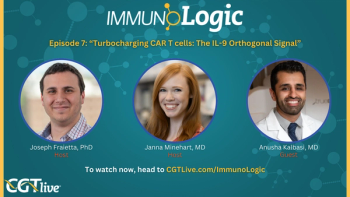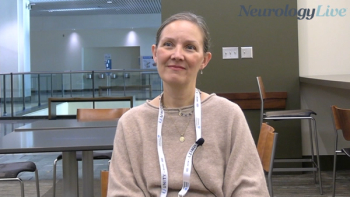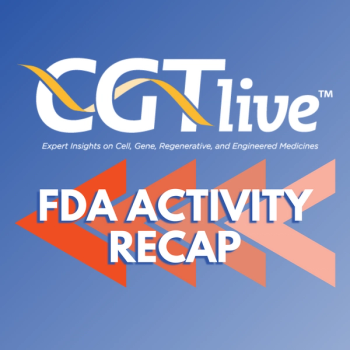
CAR T-cells Rapidly Evolving as Cancer Therapies
Chimeric antigen receptor-modified T-cell therapies have demonstrated durable complete responses for patients with relapsed/refractory B-cell acute lymphoblastic leukemia; however, several questions remain regarding their optimal use and applicability outside of this disease.
Jae H. Park, MD
Chimeric antigen receptor (CAR)-modified T-cell therapies have demonstrated durable complete responses (CRs), the majority of which are minimal residual disease (MRD)-negative, for patients with relapsed/refractory B-cell acute lymphoblastic leukemia (ALL). However, several questions still remain regarding their optimal use and applicability outside of ALL, according to Jae H. Park, MD, at the 2016 International Congress on Hematologic Malignancies.
“What we have learned from ALL is that they are very effective at getting to complete remissions, and the responses are very deep. Durable responses have been observe in a subset of patients who did not get subsequent allogeneic transplant,” said Park, Leukemia Service at Memorial Sloan Kettering Cancer Center. “There are a lot of questions, as we move forward, such as the role of the tumor microenvironment, and whether this can be applied outside of ALL.”
A CAR therapy consists of the binding domain from an antibody connected to the signaling domain of a T cell. The process for the therapy involves the insertion of a CAR gene subclone that recognizes a tumor antigen into a viral vector, which is transduced and expanded ex vivo in T cells and then administered to the patient. The resulting therapy has the specificity of an antibody with the killing capacity of a T cell, Park said.
At this point, clinical trials have primarily focused on CD19 and other markers on B-cell malignancies. CD19 was explored first, since it is not expressed in hematopoietic stem cells and is overexpressed in B-cell lymphoma, leukemia, and occasionally in multiple myeloma.
“With CD19, because it's not expressed on stems cells, we are only targeting mature cells. However, because the antigen is also expressed in normal B-cells, we do cause B-cell aplasia,” said Park. “We also have CARs planned for CD22 and CD20, which are other common B-cell antigens.”
CAR-modified T-cell therapies have undergone several changes since they were initially introduced, and continue to be improved and modified. They offer the advantage of having HLA-independent antigen recognition, which provides broad application across both solid and blood cancers. These therapies are also active in both CD4+ and CD8+ T cells, with a minimal risk of graft-versus-host disease.
Findings in Acute Lymphoblastic Leukemia
“This is potentially a living drug. They can survive within the body and provide immunity against cancer,” said Park. “Because this is a genetic therapy, the door is open to more genetic modifications and better versions of the T-cells as the years go on. In the future, we may even be able to accomplish better results, and in solid tumors as well.”Historically, patients with ALL who are in their first relapsed have a 5-year overall survival (OS) of 7% to 8% and a 2-year OS of 11%. Additionally, in clinical trials studying conventional chemotherapy, the CR rates ranged between 18% and 45% for patients with relapsed/refractory ALL. These poor outcomes emphasize the need for novel therapies, said Park.
In phase I trials exploring CAR T-cell therapies, leukapheresis is conducted upfront to collect T cells for modification followed by chemotherapy, to keep the disease in check. After the T-cell production period, which takes 2 to 3 weeks, a bone marrow biopsy is conducted to assess the response to chemotherapy. After this step, the patient will receive a conditioning chemotherapy followed by an infusion of the T-cell therapy.
“The conditioning therapy, what we think it is doing, is lymphodepletion. It simply is creating a space for these T-cells to get in there and expand. In order for this T-cell therapy to be successful, you do need T-cell activation and expansion,” said Park.
As early phase results have been analyzed, a number of modifications were made to this study design. Initially, the conditioning chemotherapy was cyclophosphamide alone; however, fludarabine has now been added, Park noted. Additionally, the second infusion of the CAR T-cell therapy is customized, based on the number of blast cells present, to address toxicity concerns.
CAR T-cells in Action
“The dosing adjustments here are counterintuitive, in a way, the more disease you have, you actually need less T-cells, since disease really means antigen load,” said Park. “The more antigen there is, the T-cells will engage and expand a lot quicker and faster, and as they do that, that is when the toxicity comes in.”As an example of the outcomes seen with CAR T-cell therapy, Park presented data from a 46-patient phase I study that was conducted by Memorial Sloan Kettering Cancer Center (NCT01044069). In this example, the median age of patients was 45 years and the median number of prior therapies was 3.1
In evaluable patients with CD19-positive B-cell ALL treated with the CAR T-cell therapy (n = 45), the overall CR rate was 82.2%. In those with morphologic disease (≥5% blasts; n = 24), the CR rate was 75% and for those with minimal disease (<5% blasts; n = 21) the CR rate was 90.5%. Of patients who achieved a CR, 83% were negative for MRD. The median time to a CR was 21 days.
In a subgroup analysis, the response rate was higher in patients with Philadelphia chromosome (Ph)-positive ALL (n = 14), with a CR rate of 92.9%. In the Ph-negative group (n = 31), the CR rate was 77.4%. Additionally, CR rates were superior in younger patients compared with adults. In those aged 18 to 30 (n = 11), the CR rate was 90.9%. In those aged 30 to 59 years (n = 10), the CR rate was 80%.
Across the full study population, the median OS was 9 months, with a 6-month OS rate of 65%. In those who achieved a CR, the median OS was 10.6 months, with a 6-month OS rate of 71%. The median OS was 10.6 months in those who did not receive a subsequent stem cell transplant and was not yet reached in those who did receive a transplant. The 6-month OS rates were similar between the two groups, at 80% and 79%, respectively.
“Standard of care says they should go on to transplant. If the patient hasn't had a transplant, we do still recommend a transplant,” said Park. “These numbers are very small, so I am not suggesting that a patient shouldn't get transplant, it still seems to be uncertain in this situation.”
This experience is not unique, in regard to efficacy, Park noted. A number of clinical trials have been conducted looking at various CAR T-cell therapies for patients with relapse/refractory ALL. Across the studies looking at these agents in adult patients, the CR rate has ranged from 83% to 89%. Additionally, in studies with OS findings, the results appear consistent between trials.
In the pediatric setting, a number of promising results have also been demonstrated. In one example exploring CTL019,2 the 6-month event-free survival (EFS) was 63%, the 6-month OS was 78%, and the CR rate was 90%. In a second study exploring KTE-C19,3 the 6-month OS and EFS rates were approximately 65% and 80%, respectively. The CR rate was 70%.
“The response rates are quite excellent across all of these studies. The follow-up is relatively short for these studies; they are all fairly new. That is something to keep in mind for these results,” Park said.
Over a dozen clinical trials are currently enrolling patients with B-cell ALL looking at CD19-targeted CAR T-cell therapies, including 4 phase II investigations. The University of Pennsylvania (NCT02030847), researchers in Sweden (NCT02132624), Juno Therapeutics (NCT02535364), and Seattle Children’s Hospital (NCT02028455) are conducting these trials.
CAR T-cell Associated Adverse Events
“Encouragingly there are some phase II trials going,” said Park. “All of these trials employ a similar design but there are some differences in the trials and therapies, such as the binding domain, the mode of transduction, cell source, patient population, and method of lymphodepletion.”The major adverse events (AEs) associated with CAR T-cell therapies are cytokine release syndrome (CRS) and neurologic changes. These occur across all of the CAR T-cell therapies, since they each have similar mechanisms of action.
“This is an infusion of T-cells, and if you have this type of event, there is really no turning the drug off or holding the drug. Once they are in, they are in,” said Park. “This is the reason we need to modify the studies to mitigate the side effects.”
A correlation exists between CRS and disease burden, which is the rationale that led to dose reductions in those with a higher disease burden. This event can be monitored using C-reactive protein levels, once detected interleuken-6 therapy can effectively treat CRS. “The IL-6 receptor inhibitor tocilizumab is highly effective at reversing the symptoms of cytokine release syndrome,” said Park.
The incidence of these toxicities has varied between clinical trials, with severe CRS occurring in as many as 92% of patients enrolled in one early study. Additionally, this event led to deaths in early studies. However, with proper management techniques now in place, severe CRS has become less common.
Ongoing Studies Outside of ALL
In addition to CRS, grade 3/4 neurotoxicity has been seen in approximately 28% of patients in some studies. At this time, the mechanism behind this event is not yet fully understood. Neurotoxicity generally consists of an altered mental state, aphasia, and seizures or seizure-like activity. “These do get better over time, and are not really prolonged in duration,” said Park.There are a number of studies exploring CAR-modified T-cells for patients with acute myeloid leukemia (AML). These studies are all phase I, and are being conducted across several sites, including the USA, China, and Australia. These therapies have a variety of CAR targets, including CD33, CD123, CD28, and NKG2D.
At this time, a single target that appears most effective has not yet been identified for patients with AML. Additionally, the off-target toxicity of these therapies remains unclear, specifically whether they could lead to prolonged or permanent myelosuppression. At this point, there is little data supporting the impact of these agents in high volume disease and the durability of response.
A number of preclinical trials are currently in progress to assess strategies to overcome the current limitations of CAR T-cell therapies for AML or solid tumors. These include the exploration of potential "on" and "off" switches to control T-cell activation. Moreover, split receptor/dual antigen-targeting T-cells are in development along with so-called "armored" CARs.
“The armored CAR T-cells involves building in additional cytokines with T-cells to be even more potent, and to take advantage of the innate immune system,” Park said.
With the number of studies currently ongoing, and the level of competition, the field continues to evolve rapidly. Outside of acute leukemia, CAR T-cell therapies are also being explored in non-Hodgkin lymphoma, multiple myeloma, and across a variety of cancers.
ReferencesÂ
- Park JH, Riviere I, Wang X, et al. Implications of Minimal Residual Disease Negative Complete Remission (MRD-CR) and Allogeneic Stem Cell Transplant on Safety and Clinical Outcome of CD19-Targeted 19-28z CAR Modified T Cells in Adult Patients with Relapsed, Refractory B-Cell ALL. Presented at: 57th American Society of Hematology Annual Meeting; Orlando, Florida; December 5-8, 2015. Abstract 682.
- Maude Sl, Frey N, Shaw PA, et al. Chimeric antigen receptor T cells for sustained remissions in leukemia. N Engl J Med. 2014;371(16):1507-1517.
- Lee DW, Kochenderfer JN, Stetler Stevenson M, et al. T cells expressing CD19 chimeric antigen receptors for acute lymphoblastic leukaemia in children and young adults: a phase 1 dose-escalation trial. Lancet. 2015;385(9967):517-528.
<<<
Newsletter
Stay at the forefront of cutting-edge science with CGT—your direct line to expert insights, breakthrough data, and real-time coverage of the latest advancements in cell and gene therapy.











































